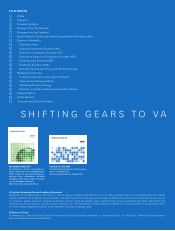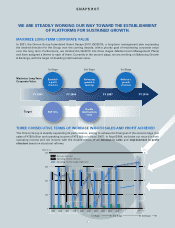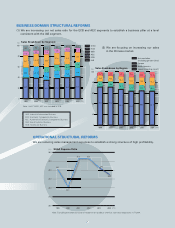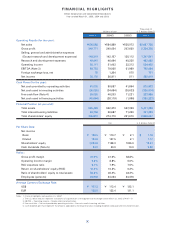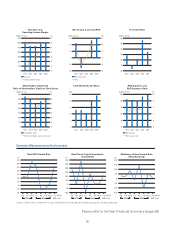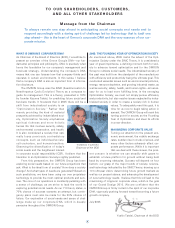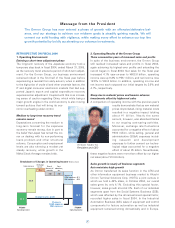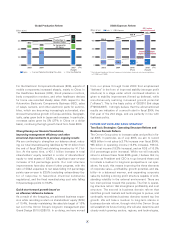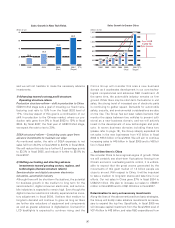Omron 2005 Annual Report Download - page 9
Download and view the complete annual report
Please find page 9 of the 2005 Omron annual report below. You can navigate through the pages in the report by either clicking on the pages listed below, or by using the keyword search tool below to find specific information within the annual report.
7
RETROSPECTIVE ON FISCAL 2004
1. Operating Environment
Entering a short-term adjustment phase
The long-term recovery of the Japanese economy took a
temporary step back in fiscal 2004, ended March 31, 2005,
as the recovery trend entered a period of short-term adjust-
ment. For the Omron Group, our business environment
remained robust in the first half of the fiscal year before
experiencing a reversal from early autumn, when in addition
to the high price of crude oil and other uncertain factors, the
IT and digital consumer electronics markets that had sup-
ported Japan’s export and capital expenditure recovery
experienced an adjustment. Coupled with this is an increas-
ing sense of caution regarding China, which while being a
major growth engine in the world economy is also moving
toward policies that will bring its eco-
nomic overheating under control.
Medium to long-term recovery trend
remains sound
Expectations concerning the medium to
long-term forecast for the Japanese
economy remain strong, due in part to
the belief that Japan has turned the cor-
ner on dealing with its non-performing
loans problem and other structural
reforms. Consumption and employment
levels are also showing a modest yet
steady recovery, while growth in the
Nikkei Stock Average remains brisk.
2. Operating Results of the Omron Group
Three consecutive years of increased sales and profits
In spite of the business environment, the Omron Group
still realized increased sales and profits in fiscal 2004,
again achieving its highest-ever profits and extending the
record began in fiscal 2003. Net sales for the fiscal year
increased 4.1% year-on-year to ¥608.6 billion, operating
income was up 9.2% to ¥56.1 billion, and net income rose
12.6% to ¥30.2 billion. In addition, operating income and
net income each outpaced our initial targets by 3.9% and
4.1%, respectively.
Steep rise in material prices and heavier advance
investments offset by higher net sales
A comparison of operating income with the previous year’s
results demonstrate that as raw material
prices skyrocketed, rising material costs
resulted in a negative impact totaling
about ¥1 billion. Nearly the same
amount, however, was absorbed thanks
to our ongoing cost-saving activities.
Moreover, exchange rate fluctuations
accounted for a negative effect of about
¥800 million, while selling, general and
administrative (SG&A) expenses includ-
ing research and development
expenses to further cement our techno-
logical edge accounted for a negative
effect of about ¥5 billion. Nevertheless,
these negative factors were more than offset by our higher
net sales (about ¥10.5 billion).
Sales growth in nearly all business segments
Asia maintains high growth
As Omron transferred its sales function in the ATM and
other information equipment business market to Hitachi-
Omron Terminal Solutions Corp. (HOTS), a joint venture in
which we hold a 45% stake, in October 2004, our overall
sales grew by only 4.1%. Excluding this special factor,
however, sales growth stood at 8%. Each of our individual
segments apart from the Social Systems Business (SSB),
which was affected by the aforementioned special factor,
recorded higher sales in fiscal 2004. In the Industrial
Automation Business (IAB), sales of equipment and control
components for factory automation as well as industrial
equipment remained strong domestically and in Europe.
The Omron Group has now entered a phase of growth with an offensive/defensive bal-
ance, and our strategy to achieve our midterm goals is steadily gaining results. We will
cement our solid footing with vigilance, while making every effort to enhance our top line
growth potential by boldly accelerating our advance investments.
HISAO SAKUTA
President and CEO
Message from the President
Breakdown of Changes in Operating Income (Billions of yen)
FY2003
Sales increase
Operating income Operating income
Exchange
losses Rise of
the cost of
materials
Cost
reductions,
etc.
Increase in
SG&A expenses -2.1
R&D expenses -2.9
FY2004
51.4
10.5
56.1
-0.8
-1.0 -1.0
Change in gross profit
Change in
SG&A expenses,
R&D expenses


